

3048A Phase Noise Test Set - Hardware Configuration
| The HP 3048A - In one of many possible configurations |
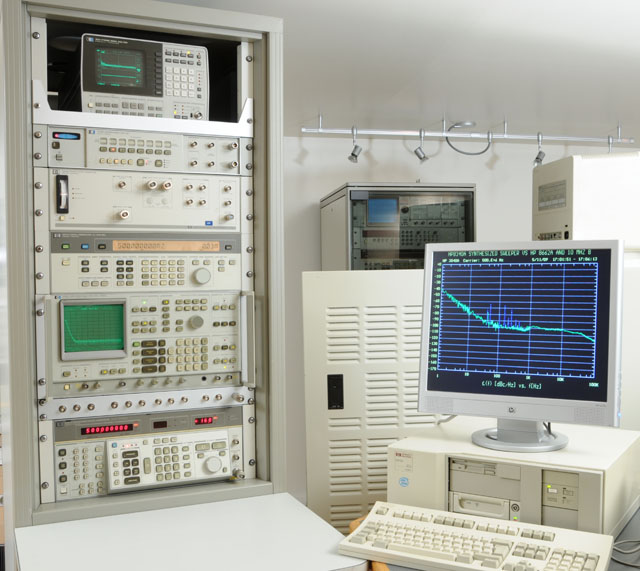 |
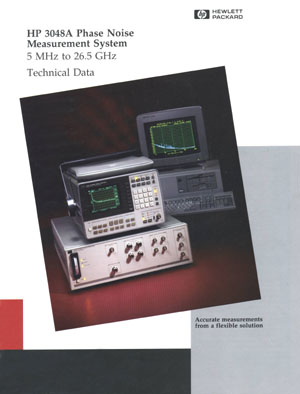 |
HP 3048A Technical Data 7/1992 |
HP 3048A Phase Noise,
Hardware Configuration
Many different hardware configurations are possible with the 3048A. Starting from a basic system and adding complementary instruments will enlarge the field of application covered by the system. The HP3048A was sold by HP as a basic system, with available options covering frequency range and measurement technique.
The many possible configurations available in 1992 are summarized in the Technical Data paper shown on the right, and available for download here.
HP 3048A Phase Noise - Which Hardware ? Which Measurement ?
The Basic HP 3048A System includes a HP 11848A Phase Noise Interface and a HP 3561A, FFT Signal Analyzer, under the control of a computer. The HP 11848A Phase Noise Interface allows several measurement techniques for phase noise and AM noise measurements. Inside this interface are the phase detectors, amplifiers, filters, and switches necessary to measure phase noise over a frequency range of 5 MHz to 1600 MHz (or 5 MHz to 18 GHz with option 201.) The interface has also four built-in signal sources that allow the system to functionally check its entire signal handling circuitry. These very low noise internal signal sources can be used as single frequency reference, to test oscillators, at spot frequencies of 10 MHz or 400 MHz, and VCOs between 350 and 500 MHz.
The HP 3561A Dynamic Signal Analyzer makes Fourier-type measurements for quantifying the demodulated phase noise . The 3561A measures the noise data from the 11848A Interface to a maximum of 100 KHz offset frequency. It is also extensively used for the system calibration and real-time monitoring.
| HP11848A --------------- HP 3048 Phase Noise Measurement Basic System -------------- HP3561A |
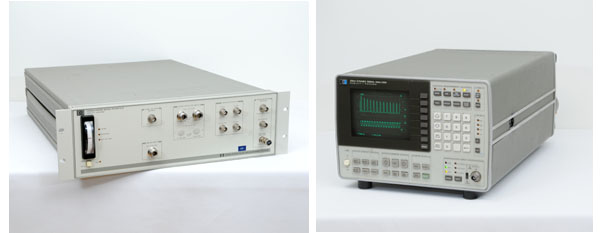 |
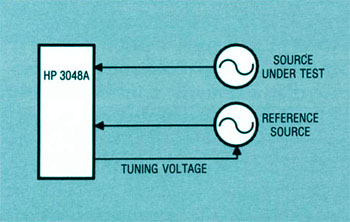 |
HP 3048A Basic Measurement Configuration |
The Basic Config.
The Basic HP 3048A System includes a HP 11848A Phase Noise Interface and a HP 3561A, FFT Signal Analyzer, under control of a computer.
This is the "entry-level," economical configuration to measure phase noise with your own tunable source. The reference source could be any signal generator, synthesizer or home-made oscillator having an external frequency tuning input. The reference source must have similar or better phase noise as the source under test. The measurement frequency range will be defined by the reference source and the 3048A phase detector: 5 to 1600 MHz with the standard instrument and up to 18 GHz with the optional microwave phase detector (Option 201.) The phase noise measurement maximum offset from carrier will be 100 KHz for this basic configuration. At the minimum, the resulting curve displayed could be set as low as 0.1 Hz offset from the measured carrier.
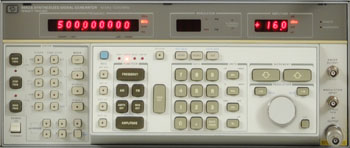 |
HP 8662A |
Adding a Low-Noise Reference
 |
HP 3048A Adding a Low-Noise Reference to the Configuration |
The Low-noise Reference Config.
Several Hewlett Packard synthesized signal generators could be used with the 3048A for completely automated phase noise measurements.
During the 1990s, the best source available was the HP 8662A. It is still today one of the most "Clean" sources available in its 10 KHz to 1280 MHz frequency range.
Adding a 8662A synthesizer to the 3048A provides a phase noise measurement system with guaranteed and specified phase noise performance. A special option was developed by HP for the 8662A. The option 003 adds a 640 MHz fixed frequency output having a specified SSB phase noise. This signal is to be used as the drive signal for the 11729C down-converter which will enlarge the frequency coverage of the system to the microwave spectra.
 |
HP 8642A |
The HP 8642A is another possible choice. Performance will be lower when measuring close to carrier phase noise, but better than with the 8662A when the measurement must be done above 1 KHz from the carrier.
Phase noise of a 8663A and a 8642B are compared on the curve below. ( the 8662A and 8663A have the same phase noise level up to 1280 MHz ).
| Phase Noise of HP 8663A vs HP 8642B Courtesy of John Miles KE5FX |
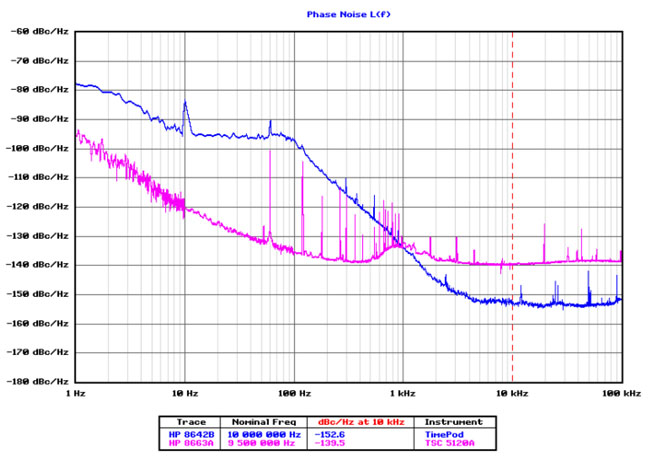 |
Another interesting graph is shown below. It comes from a Hewlett Packard Signal Generator Selection Guide edited in 1997. It is a comparison of the typical phase noise of many HP signal sources. Some of these sources are available at reasonable price on the today second hand market.
| Phase Noise of Various HP Signal Sources - From a 1997 Signal Generator Selection Guide Courtesy of the Hewlett Packard Company |
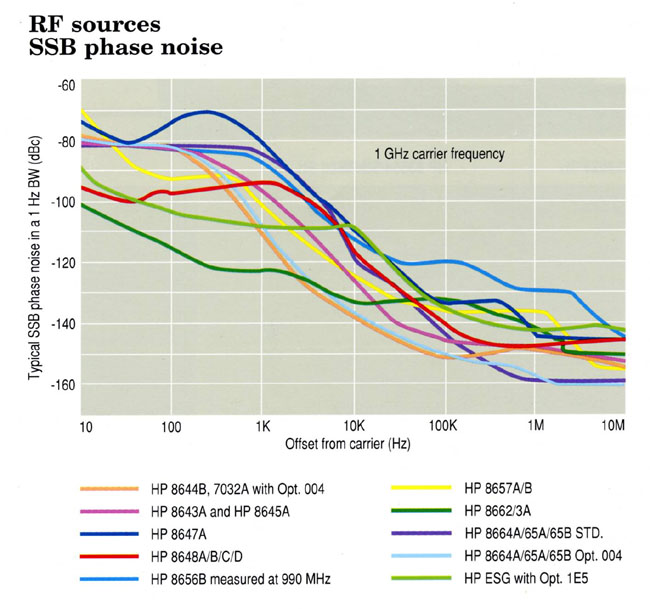 |
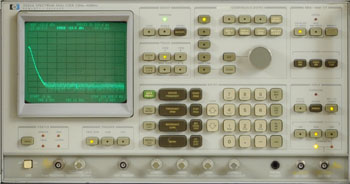 |
HP 3585A |
Adding a RF Spectrum Analyzer
 |
HP 3048A Adding a RF Spectrum Analyzer to the Configuration |
Up to 40 MHz Offset from Carrier
The maximum offset from carrier phase noise measurement range of the basic HP 3048 system is limited to 100 kHz by the 3561A frequency range.
To extend the "Offset from Carrier" measurement range of the 3048 system, a second spectrum analyzer will be necessary.
Several spectrum analyzers can be controlled by the HP 3048A system for calibrated phase noise measurements at offsets up to 40 MHz.
The HP 3585A, shown above, is recommanded, however, the 8568A/B or 8566A can do the job too. Any of them, under HP-IB control, could be addressed by the system with the specific programing syntax included in the HP 3048A software.
 |
HP 11729C |
Adding a Microwave
Down-Converter
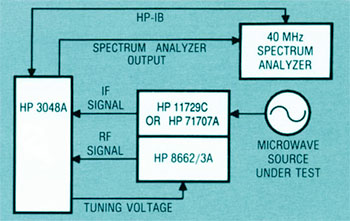 |
HP 3048A Adding a Microwave Down-Converter to the Configuration |
Up to 18 GHz
The HP 11729C is primarily a down-converter which extend the 3048A frequency range up into the microwave spectra.
Many different configurations were possible, and the instrument could be delivered with the specific frequency coverage needed and ordered by the customer. When full coverage from 10 MHz up to 18 GHz is necessary, the instrument is loaded with a bank of seven microwave bandpass filters and their associated microwave relays. A 11729C in such a configuration is shown on the picture below.
| Inside View of the HP 11729C Loaded With Every Passband Filters, and Detail of their Frequency Range |
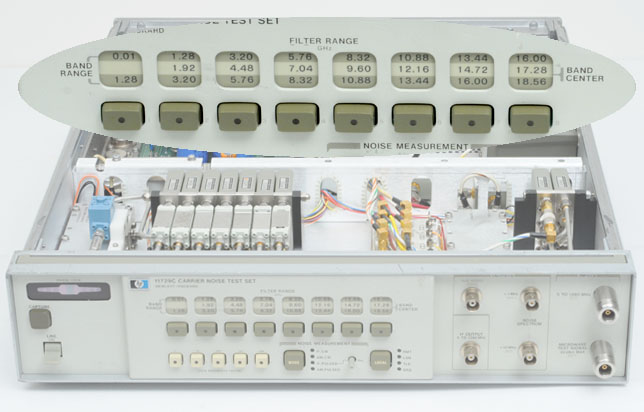 |